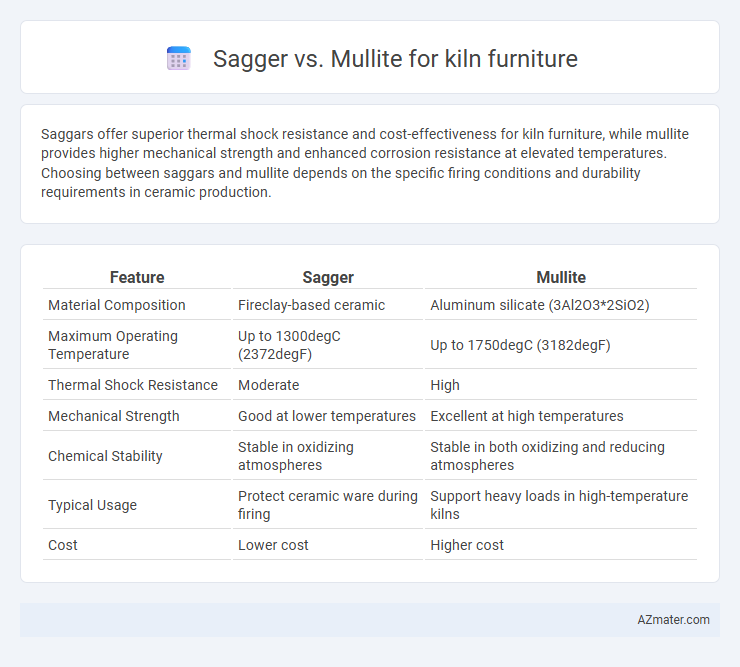Saggars offer superior thermal shock resistance and cost-effectiveness for kiln furniture, while mullite provides higher mechanical strength and enhanced corrosion resistance at elevated temperatures. Choosing between saggars and mullite depends on the specific firing conditions and durability requirements in ceramic production.
Table of Comparison
| Feature | Sagger | Mullite |
|---|---|---|
| Material Composition | Fireclay-based ceramic | Aluminum silicate (3Al2O3*2SiO2) |
| Maximum Operating Temperature | Up to 1300degC (2372degF) | Up to 1750degC (3182degF) |
| Thermal Shock Resistance | Moderate | High |
| Mechanical Strength | Good at lower temperatures | Excellent at high temperatures |
| Chemical Stability | Stable in oxidizing atmospheres | Stable in both oxidizing and reducing atmospheres |
| Typical Usage | Protect ceramic ware during firing | Support heavy loads in high-temperature kilns |
| Cost | Lower cost | Higher cost |
Introduction: Understanding Kiln Furniture
Kiln furniture, essential for supporting ceramic wares during firing, requires materials with exceptional thermal stability and resistance to high temperatures. Saggers, typically made from refractory clays or ceramic fibers, provide protective enclosures to shield products from direct flame and contaminants. Mullite, a key alumina-silicate ceramic, offers superior strength, thermal shock resistance, and longevity, making it ideal for structural kiln furniture components exposed to intense heat.
What is Sagger? Definition and Uses
A sagger is a high-temperature refractory container used in kiln furniture to protect ceramic ware or metal parts during firing, preventing direct flame or gas contact. Typically made from materials like fireclay or mullite, saggers ensure uniform heat distribution and minimize contamination or distortion of the items inside. Their primary uses include shielding delicate ceramics, supporting glazing processes, and enhancing product quality in various high-temperature industrial applications.
Overview of Mullite in Kiln Applications
Mullite is a preferred material for kiln furniture due to its excellent thermal stability and resistance to thermal shock, making it ideal for high-temperature kiln environments. Its low thermal expansion and strong mechanical strength ensure durability and minimal deformation during repeated heating and cooling cycles. This refractory material maintains structural integrity while supporting ceramic ware, enhancing kiln efficiency and product quality.
Material Composition: Sagger vs Mullite
Sagger is typically made from fireclay or alumina-based materials, designed to protect products during firing by providing a controlled atmosphere, whereas Mullite consists primarily of 3Al2O3*2SiO2, a highly refractory ceramic known for its excellent thermal stability and resistance to chemical attack. Mullite's high alumina content gives it superior mechanical strength and thermal shock resistance compared to the more porous and less dense sagger materials. The choice between sagger and mullite depends on the specific kiln firing requirements, with mullite favored for high-temperature, long-duration firings due to its durability and low thermal expansion.
Thermal Performance and Heat Resistance
Sagger and mullite both exhibit excellent thermal performance for kiln furniture, with mullite offering superior heat resistance due to its high melting point around 1840degC and low thermal expansion, making it ideal for repeated thermal cycling. Saggers, typically made from fireclay or alumina, provide good insulation and moderate heat resistance but may degrade faster under extreme kiln conditions compared to mullite. The enhanced durability and thermal shock resistance of mullite result in longer service life and more consistent performance in high-temperature firing applications.
Mechanical Strength and Durability
Sagger and mullite are critical materials for kiln furniture, with mullite offering superior mechanical strength due to its high thermal stability and resistance to thermal shock. Mullite's microstructure enhances durability under repeated high-temperature cycles, reducing deformation and increasing lifespan compared to traditional sagger materials. Saggers, typically made from fireclay or alumina, provide good thermal insulation but generally lack the long-term mechanical resilience and durability of mullite in harsh kiln environments.
Chemical Stability and Reactivity
Saggars exhibit moderate chemical stability but can react with volatile compounds in the kiln atmosphere, leading to potential contamination of the ware. Mullite, a crystalline aluminosilicate, offers superior chemical stability and minimal reactivity at high temperatures, resisting fluxation and degradation during firing. This makes mullite kiln furniture ideal for preserving the integrity of ceramic products in aggressive firing environments.
Cost Comparison: Sagger vs Mullite
Sagger kiln furniture typically costs less upfront compared to Mullite, making it a budget-friendly option for short-term or less demanding firing processes. Mullite offers higher durability and thermal stability, which reduces replacement frequency and long-term expenses despite higher initial investment. Choosing between Sagger and Mullite depends on balancing immediate cost savings against longevity and performance efficiency in kiln operations.
Best Applications for Sagger and Mullite
Sagger materials are best suited for protecting delicate ceramic pieces during firing by providing a barrier against ash, glaze drips, and kiln atmosphere contamination, making them ideal for intricate ceramic ware and glassworks. Mullite, known for its excellent thermal shock resistance and mechanical strength, is optimal for kiln furniture such as setters, stilts, and kiln shelves used in high-temperature firings, particularly in industrial ceramics and porcelain production. Using saggers enhances product quality by preventing direct contact with flames and deposits, while mullite kiln furniture ensures durability and stability under repeated heating cycles.
Choosing the Right Kiln Furniture Material
Sagger and Mullite are critical kiln furniture materials with distinct properties influencing kiln performance and product quality. Mullite offers exceptional thermal stability, resistance to thermal shock, and mechanical strength, making it ideal for high-temperature applications in ceramic and glass firing. Sagger, primarily used as a protective container, provides a controlled atmosphere to prevent contamination but lacks the structural strength of Mullite, thus making Mullite the preferred choice for durable and efficient kiln furniture.

Infographic: Sagger vs Mullite for Kiln furniture
 azmater.com
azmater.com